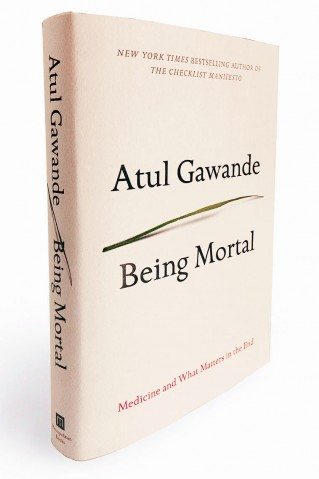 In November of 2013 BCCPA attended a breakfast event hosted by Canadian College of Health Leaders (CCHL) featuring keynote speaker Stephen Brown, Deputy Minister of Health. During his speech Brown referenced and recommended a book entitled Being Mortal: Medicine and What Matters in the End by author Atul Gawande which revisits aging and, in particular, the way people look at end-of-life.
In November of 2013 BCCPA attended a breakfast event hosted by Canadian College of Health Leaders (CCHL) featuring keynote speaker Stephen Brown, Deputy Minister of Health. During his speech Brown referenced and recommended a book entitled Being Mortal: Medicine and What Matters in the End by author Atul Gawande which revisits aging and, in particular, the way people look at end-of-life.
Michael Kary, Director of Policy and Research subsequently read the book and has provided a brief review and discussion of the state of palliative care in Canada/BC. Read Kary’s review below.
+++
Op-Ed: Re-visiting End-of-Life Care in Canada
Michael Kary
January 2015
One of the best books I read in 2014 and would recommend for anyone’s reading list for 2015 is Being Mortal: Medicine and What Matters in the End by author Atul Gawande. Gawande, who has authored several other books and is a surgeon at Brigham and Women’s hospital in Boston provides a very interesting perspective about how we look at the aging process, in particular end-of-life care.
 The first part of book deals in depth about the institutionalization aspect of nursing or long-term care homes. It outlines many of the negative perceptions such as the institutional setting, lack of personalized care and poor food quality. It also provides an overview of how long-term care homes developed in the United States; first with the creation of Poor Houses, which were essentially institutions for many poor people who had no other place to go. The standards provided in Poor Houses were often deplorable and as one report notes were unfit to decently house animals.
The first part of book deals in depth about the institutionalization aspect of nursing or long-term care homes. It outlines many of the negative perceptions such as the institutional setting, lack of personalized care and poor food quality. It also provides an overview of how long-term care homes developed in the United States; first with the creation of Poor Houses, which were essentially institutions for many poor people who had no other place to go. The standards provided in Poor Houses were often deplorable and as one report notes were unfit to decently house animals.
With the passage of the Hill Burton Act in 1946 and creation of Medicare in 1965, this fostered the movement of seniors into hospitals and then into nursing homes, particularly in the 1970s with the creation of thousands of such homes across the United States. The book also discusses the concept of assisted living which began in the early 1980s to essentially replace nursing homes altogether by creating more home like environments for seniors but has instead evolved to become almost anything related to supportive housing.
Along with assisted living, the book discusses other new models or approaches to nursing homes such as the Eden Alternative and Green Houses, which are also intended to reduce the institutional aspects of long-term care and create a more home like environment.[1] Although these models have been around for a while they are still being looked at as alternatives to the status quo.
Another of the major themes of the book is around the over medicalization of the health system, particularly seniors who are nearing end-of-life. In particular, it recounts a number of examples where people are diagnosed with a terminal illness but are often given medical treatments that are likely to have no or little benefit to patients. In many cases such treatments, including medications, have negative side effects and instead of improving a patient’s quality of life make their situation worse.
In the broader sense, we see the over medicalization within the health system beyond just end-of-life as seen with the development of campaigns such as Choosing Wisely Canada.[2] This is a campaign that started in the United States, to help physicians and patients engage in conversations about unnecessary tests, treatments and procedures and make smart and effective choices to ensure high-quality care.
The second part of Being Mortal deals more with the author’s personal encounters with his patients and others including his father towards their final years as well as discusses controversial issues such as assisted suicide. For me after reading the book it particularly highlights several areas that today’s health system could better address. As touched upon earlier, the first is the need to address the over medicalization of the health system where procedures of little or no benefit are routinely performed. A Canadian survey, for example, highlights that 70% of hospitalized elderly patients prefer comfort measures or measures to reduce pain as opposed to life prolonging treatment.[3]

The second area is the need to address the issue of improving or lessening the institutional perceptions of long-term care by looking at ways to make such facilities better suited to people nearing end-of-life. Although progress has been made on this, more needs to be done to change and improve such perceptions. The third and final area is to begin altering the view that end-of-life should be more about extending one’s life at any cost to one of well-being. Related to this is also the notion that we are not going to live indefinitely so we should not postpone what is truly important in our lives.
The issues raised in the Being Mortal and highlighted in numerous reports including most recently Health Quality Ontario’s End-of-Life Health Care report,[4] show that we need to better address issues around palliative care. The Ontario report highlights that just 30 percent of people with chronic illnesses have access to team-based palliative care – most being people with cancer.[5] Not only do we need to look at the resources provided towards palliative care, including potential development of a national strategy, but we also need to address tough issues such as over medicalization, institutionalization and seeking ways to improve well-being at end-of-life including ensuring a dignified death.
Now is the time for action on these issues as the situation is only going to grow over time. By 2026, with the aging population, the number of Canadians dying each year will increase by 40 percent to 330,000 people. Each of these deaths will affect the well-being of an average of five other people, including families and loved ones, or in excess of 1.6 million.[6] Although the BC Government has made some progress in the area of palliative care such as the creation of the Provincial End-of-Life Care Action Plan[7] and committing to double the number of hospice beds by 2020, more action and discussion is required.
In particular, along with improving capacity through the building of new hospice beds, it will be important to ensure greater continuity with end-of-life and the continuing care sector. Currently palliative care services are often inadequately integrated into residential long-term care, and staff and physicians are often unprepared to discuss end-of-life wishes and expectations with residents and their families.[8] It will also be important to ensure that along with building the necessary infrastructure that continuing care facilities are appropriately resourced to meet increased demands and that staff are appropriately trained as such.[9] The BC Care Providers Association hopes to begin such a discussions including how to improve the future of the palliative care system at its 2015 Annual Conference.
[1] The Green House Effect: Homes for the Elderly to Thrive. Jane E. Brody. New York Times.
December 15, 2014. Accessed at: http://well.blogs.nytimes.com/2014/12/15/moving-away-from-nursing-homes/?_r=3
[2] For further information see: http://www.choosingwiselycanada.org/
[3] Fowler R, Hammer M. End-of-life care in Canada. Clin Invest Med. 2013; 36(3):E127-E132.
[4] End-of-Life Health Care in Ontario. Health Quality Ontario. December 2014. Accessed at: http://www.hqontario.ca/Portals/0/Documents/eds/synthesis-report-eol-1412-en.pdf
[5] Local Health Integration Networks, Quality Hospice Palliative Care Coalition of Ontario. Advancing high quality, high value palliative care in Ontario: a declaration of partnership and commitment to action [Internet]. [updated 2011]
[6] Quality End-of-Life Coalition of Canada. Blueprint for action 2010 to 2020. 2010, p. 19
[7] In March 2013, the BC government announced its Provincial End-of-Life Care Action Plan for British Columbia to improve access to end-of-life care so people can remain at home and in their community longer. This included funding to establish a centre for excellence.
[8] McGregor, M.J., R.B. Tate, K.M. McGrail. 2007. “Variation in Site of Death among Nursing Home Residents in British Columbia, Canada.” Journal of Palliative Medicine 10 (5): 1128-36.
[9] BCCPA 2015 Budget Submission. October 2015. Accessed at: https://bccare.ca/file/BCCPA-Budget-Submission-2015-Final.pdf





